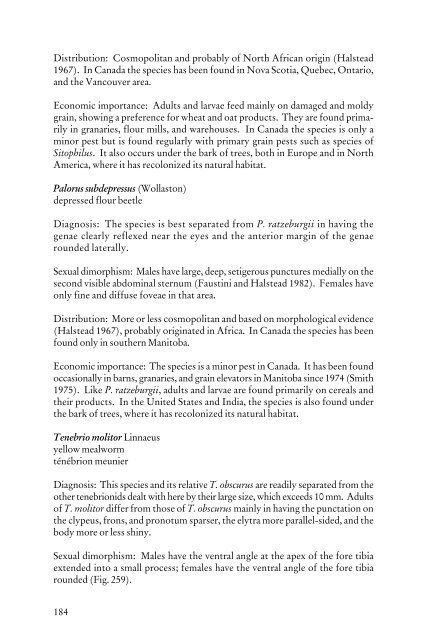Beetles Identification Guide
Beetles Identification Guide
Beetles Identification Guide
You also want an ePaper? Increase the reach of your titles
YUMPU automatically turns print PDFs into web optimized ePapers that Google loves.
Distribution: Cosmopolitan and probably of North African origin (Halstead<br />
1967). In Canada the species has been found in Nova Scotia, Quebec, Ontario,<br />
and the Vancouver area.<br />
Economic importance: Adults and larvae feed mainly on damaged and moldy<br />
grain, showing a preference for wheat and oat products. They are found primarily<br />
in granaries, flour mills, and warehouses. In Canada the species is only a<br />
minor pest but is found regularly with primary grain pests such as species of<br />
Sitophilus. It also occurs under the bark of trees, both in Europe and in North<br />
America, where it has recolonized its natural habitat.<br />
Palorus subdepressus (Wollaston)<br />
depressed flour beetle<br />
Diagnosis: The species is best separated from P. ratzeburgii in having the<br />
genae clearly reflexed near the eyes and the anterior margin of the genae<br />
rounded laterally.<br />
Sexual dimorphism: Males have large, deep, setigerous punctures medially on the<br />
second visible abdominal sternum (Faustini and Halstead 1982). Females have<br />
only fine and diffuse foveae in that area.<br />
Distribution: More or less cosmopolitan and based on morphological evidence<br />
(Halstead 1967), probably originated in Africa. In Canada the species has been<br />
found only in southern Manitoba.<br />
Economic importance: The species is a minor pest in Canada. It has been found<br />
occasionally in barns, granaries, and grain elevators in Manitoba since 1974 (Smith<br />
1975). Like P. ratzeburgii, adults and larvae are found primarily on cereals and<br />
their products. In the United States and India, the species is also found under<br />
the bark of trees, where it has recolonized its natural habitat.<br />
Tenebrio molitor Linnaeus<br />
yellow mealworm<br />
ténébrion meunier<br />
Diagnosis: This species and its relative T. obscurus are readily separated from the<br />
other tenebrionids dealt with here by their large size, which exceeds 10 mm. Adults<br />
of T. molitor differ from those of T. obscurus mainly in having the punctation on<br />
the clypeus, frons, and pronotum sparser, the elytra more parallel-sided, and the<br />
body more or less shiny.<br />
Sexual dimorphism: Males have the ventral angle at the apex of the fore tibia<br />
extended into a small process; females have the ventral angle of the fore tibia<br />
rounded (Fig. 259).<br />
184
















